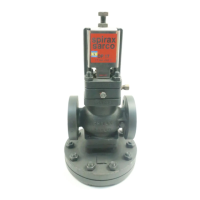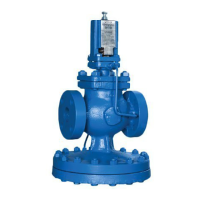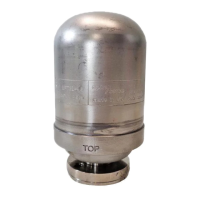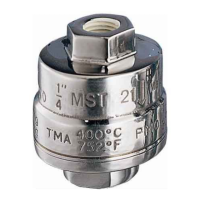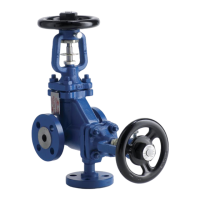7
Maintenance
General Inspection
While a program of planned maintenance is always to be
recommended, the Spirax Sarco 25P valve will give long
and trouble-free service if correctly selected, installed and
kept reasonably free of dirt and foreign matter. Dirt and
foreign matter are most likely to collect during installation
and later trouble can be avoided by inspecting the installa-
tion after a few days. Check the following:
1. Clean all pipeline strainers. (Remove screens to clean.)
2. Check the main valve seat (1E) and protective screen
(1D).
3. Inspect and clean orifices (B) and (H).
4. Check all joints for leakage.
Servicing Procedure (Refer to Fig. 6 and 9)
To determine which part of a malfunctioning pressure
reducing valve requires maintenance, refer to the trouble-
shooting chart and follow this servicing procedure to
check the tightness of the seats.
1. With all stop valves closed and the valve cooled down,
remove the copper tubing from connectors (J) and (L)
being careful not to bend them.
2. Close the pilot valve (2H) by turning the pressure
adjustment (2D) counter-clockwise until the spring is
slack. (No air pressure supplied to the type PA pilot).
3. Stand clear of the tubing connectors and open the inlet
stop valve slightly so that a small amount of steam
reaches the valve inlet and pilot.
4. Open and close the pilot valve a few times by turning
the pressure adjustment (2D) and observe the steam
flow from tubing connectors (J) and (L). When the pilot
valve is closed, there should be no steam flow from
the connectors; if there is some steam flow, it indicates
that the pilot valve assembly (2H) is faulty and must be
replaced.
5. With the copper tubing removed the main valve head
and seat are held closed and should not pass any
steam. Observe the downstream orifice connector (B).
Steam flow from this connector indicates that the main
valve head and seat are leaking and require servicing.
Inspecting and Replacing Pilot Valve Head
and Seat (Refer to Fig. 6 and 9)
1. Remove 4 pressure pilot flange cap screws and lift off
pressure pilot. Visual examination can be made of the
pilot valve head and seat.
2. Pilot valve head and seat are contained in one com-
plete assembly. (See Fig. 6.)
3. To remove head and seat assembly (2H), unscrew
hexagon, using 11/16” hex wrench.
4. If it is found that either the head or seat is worn, the
entire assembly should be replaced.
Inspecting and Replacing Pilot Valve
Diaphragms (Refer to Fig. 6 and 9)
1. Turn adjustment screw (2D) counterclockwise until
spring is slack. Air loaded PA pilots must have no air
pressure supplied to them.
2. Remove cap screws (2C). Pilot yoke (2B) can then be
removed.
3. The 2 metal diaphragms (2F) can then be inspected for
distortion or possible fracture as a result of abnormal
operation.
4. At the same time any accumulation of dirt or foreign
material should be removed from the lower diaphragm
pilot case.
5. When replacing diaphragms, make certain casting sur-
face is clean to insure a steam tight joint. Application
of a plastic compound on the casting surface, such as
Garlock 101, is recommended.
6. Position pilot yoke on lower diaphragm pilot casting
making certain that the yoke is properly centered.
7. Tighten all cap screws uniformly. To an assembly
torque of 15-20 ft/lbs.
Valve Sizes 1/2” Thru 4”
Inspecting and Replacing Main Valve Head
and Seat (Refer to Figs. 6, 7, and 9)
1. Unscrew copper tubing connections at (J) and (L).
2. Remove main valve cover cap screws (1A).
3. Remove main valve cover, strainer screen (1D), spring
support disc and head spring.
4. Head can then be removed by simply withdrawing with
a pliers or similar tool.
5. Inspection should then be made to determine if scale
or other foreign material prevented tight closure of the
head and seat.
6. If it is necessary to replace the valve seat, this can be
removed from the valve body using a standard hexa-
gon socket. (Valve sizes 1/2” to 2”.) When replacing
the valve seat, a new gasket should be used to insure
a tight joint.
2-1/2” thru 6” valves contain raised lugs for
removal and seal metal-to-metal without a gasket.
Replacement heads and seats should be lapped
in.

